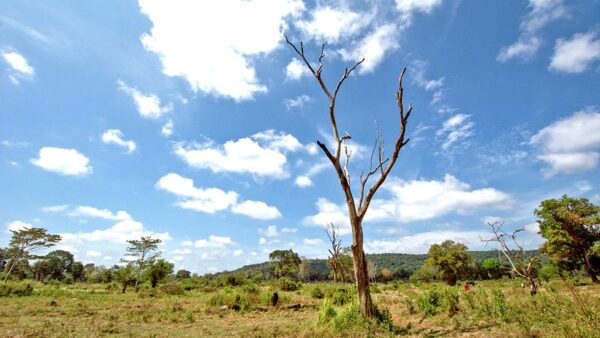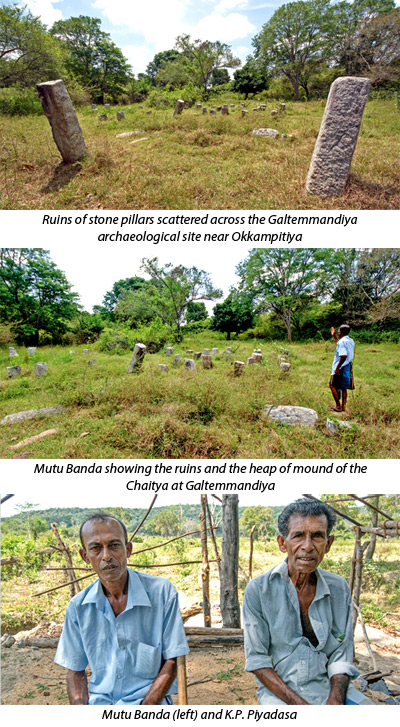General
Unearthing ancient artefacts in Yala environs




An abandoned chena near the Galtemmandiya
Source:sundayobserver.lk
A couple of years since our last visit, we were heading back to Moneragala, a drought stricken district in the Uva Province. It is always an adventure to head to Pahala Uva, especially, if you like to travel using your own transport. The 4×4 ride is a great way to get a glimpse of the culture and life of the people in the region.


However, this time around, we had a specific purpose – on a previous visit to the Maligawila archaeological site, I came across an information board showing the nearby archaeological sites with illustrations. The board highlighted a lesser known ancient site called Galtemmandiya with a picture, a map and the distance. This intrigued me enough to embark on this journey.
I had always wanted to see the ruins of ancient Buddhist sites hidden in the forest canopies in thick jungles, neglected and unknown to the outside world. So, my son and I had an opportunity when my friend offered to organise a trip.
It was early morning and the rays of the sun filtered through the huge trees. First, we arrived in Okkampitiya, a small township, travelling on the Wellawaya-Buttala-Moneragala (A4) highway. We turned right from Buttala and proceeded a few yards, turned left and proceeded another ten kilometres on a narrow carpeted road to reach Okkampitiya.
Kumbukkan Oya
Okkampitiya nestled on the edge of Yala Block IV, bordering Kumbukkan Oya and home to chena cultivation and illicit gem mining in the bank of the Kumbukkan Oya. To visit Galtemmandiya, we were accompanied by two experienced villagers, R.M. Mutu Banda, caretaker of the Habassa archaeological site and K.P. Piyadasa, an elderly farmer from Okkampitiya, an expert on the movements of wild elephants.
We made our way slowly across the Kumbukkan Oya, thanks to its low water level, due to the prevailing dry weather. We glimpsed a shallow river bed with a rocky surface, and wide empty banks. The banks suggest the massive width and depth of the river during the rainy season. We drove through the river bed easily under the dark canopy formed by massive Kumbuk trees.
If the Kumbukkan Oya overflows during rainy days, no one can cross the river by vehicle, and a hanging bridge would have to be used. Peacocks constantly voiced their irritation at the approaching vehicle, while the hawk eagles took quick flight, and we had our eyes and ears peeled for any sight or sound of wild elephants.
We ventured towards the edge of Yala Block-IV bordering Kumbukkan Oya and drove along the beaten track across the just harvested and abandoned chena cultivation before approaching the magnificent ruined archaeological site of Galtemmandiya, on the way to Habassa.


After travelling around two kilometres on the narrow gravel path amid the forest canopy, Mutu Banda signalled to stop the jeep under a shady tree ahead. He, then, took us to see the once upon a time famous, sprawling, ruined Galtemmandiya ancient temple complex.
Stone pillars
Following a narrow gravel footpath, we first caught a glimpse of an uneven cluster of short ancient stone pillars, half fallen or lying in pieces in a wide area overgrown with ferns. Unlike other places, here, we couldn’t see any rocky boulders or caves as it lies in a flat land. It is sad to see some sections dug up and the stone slabs removes by treasure hunters in search of gems.
Venturing further, we came across countless ruins inside the shrubs, reminding us that this was once a great Buddhist shrine that enjoyed royal patronage. “See the shape of the mound of heap there, it is believed to be the remains of a crumbling Chaitya”, said Mutu Banda pointing to a mound of earth and broken bricks overgrown with scrub in the middle of the ruins, scattered across a vast area.
Surprisingly, we had not heard of the Galtemmandiya from any guidebook or historical record. Archaeologists have to survey, explore and document, and most of the site’s secrets should be unearthed through exploration.
According to Mutu Banda, the Habassa archaeological temple complex and its vandalised Buddha statue (now restored) probably date back to 8th century AD. He believes Galtemmandiya archaeological site may have had close connections with Habassa, belonging to the same period.
We observed the stone pillars closely for a few minutes. Although the monuments looked beautiful at a distance, most of the details of the stone carvings were disfigured by the weather.
This imposing archaeologically important ancient complex needs urgent conservation through exploration.
The Galtemmandiya archaeological site encompassing around five acres, lies in a pathetic state today, not so much due to neglect as due to vandalism and ignorance of the villagers who live off the jungle. Galtemmandiya and the adjoining Kumbukkan Oya, a famous gem mining area, have become the target of treasure hunters and illicit gem miners from nearby villages, who have caused grave destruction to the Galtemmandiya archaeological site.
Mutu Banda said, “All this took place in this area after 1989. Villagers who lived close by kept away from the sites due to armed gangs and LTTE terrorists’ presence. Many villagers were massacred by terrorists, and now, we face the wild elephant menace”.
Before we proceeded, we overcame the fatigue with a delicious piece of watermelon from a chena, while taking a refreshing dip in the Kumbukkan Oya, to wear off the mid-day heat.








